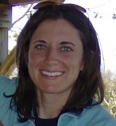 |
|
My name is Mary Culler. I work for the Missouri Department of Natural Resources in the Northeast Regional Office in Macon.
|
The department recently launched a new watershed management approach that we call Our Missouri Waters initiative. We have started in three pilot watersheds; the Big River, the Spring River, and the Lower Grand River. I am the coordinator for the Lower Grand River watershed.
As the Lower Grand River Watershed coordinator, I want to be able to find out what resources exist, which ones you want to improve, and to help you find the funding and the guidance needed. I am wanting to meet with all interested people that live and work in this watershed, listen to watershed residents about water quality and water quantity concerns, and help focus resources towards these areas of concern. I am also looking forward to working to help increase awareness of water resources in this area, by meeting with local educators, reaching out through the media, and participating in and organizing special events.
If you live or work in this watershed, I hope to have a chance to talk to you. I can be reached at 660-385-8000 or at Mary.Culler@dnr.mo.gov.
I have also set up a Facebook page for the watershed, where I post news events, grant opportunities, and pictures from the watershed. If you are a Facebook user, please visit the “Our Missouri Waters Lower Grand River Watershed Initiative” and Like your watershed’s page.
I would like to include a Q & A section in future editions, please email Mary.Culler@dnr.mo.gov with your questions. >>OMW>>
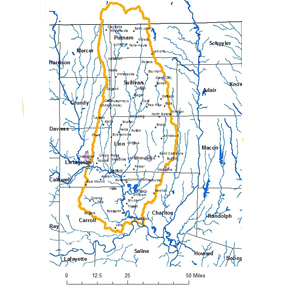
A watershed is the area of land where the water that falls as precipitation in that area drains to a certain body of water. Creeks, streams, rivers, ponds, lakes, reservoirs and wetlands all have watersheds. Where ever you travel, live, work, or recreate, you are always in a watershed. Another name for a watershed is a drainage basin.
The Lower Grand River Watershed is located in north-central Missouri and drains 2,360 square miles (about 1.5 million acres) of portions of eight counties, including Putnam, Sullivan, Mercer, Grundy, Linn, Livingston, Carroll and Chariton counties. Major tributaries within this watershed include Medicine Creek, Locust Creek, Yellow Creek, Elk Creek, Turkey Creek, Muddy Creek, Parson Creek, Big Creek and Salt Creek. The Grand River meets the Missouri River at Brunswick, at the most downstream portion of this watershed.
We all live in a watershed. Our actions within each watershed can directly impact both the water quantity and water quality of the surface water and groundwater within the watershed. >>OMW>>
HUC stands for Hydrologic Unit Code. The Hydrologic Unit Code system was developed by the United States Geological Service (USGS). With this system, a watershed has an identifying code made up of a series of numbers. The number of digits in that code increases as the watershed’s size gets smaller. For example, the Missouri River Basin is identified by a 2-digit code (10). Within the Missouri River Basin is the Chariton and Grand River watersheds, which are identified together with a 4-digit code (1028). Within this Chariton-Grand River 4-digit unit, we have the Grand River Watershed which is identified by 6 digits (102801). The Grand River Watershed consists of three 8-digit watersheds: The Upper Grand River Watershed (10280101), the Thompson River Watershed (10280102), and the Lower Grand River Watershed (10280103).
The Our Missouri Waters initiative is focusing its work on watersheds at the 8-digit HUC level. The three pilot phase watersheds are 8-digit HUC watersheds. Therefore, the Lower Grand River Watershed area does not consist of the entire land area that drains water to the Grand River in Missouri (this consists of the three HUC 8 watersheds listed above). Instead, the Lower Grand River Watershed consists of the land area that drains water to the tributaries that feed into the lower portion of the Grand River. There are 66 HUC 8 watersheds in Missouri. The 8-digit HUC basin is being proposed as the manageable unit for organizing the department activities at a watershed level. >>OMW>>

The 66 HUC 8 Watersheds in Missouri. The three Our Missouri Waters pilot watersheds are shown in dark blue.
Mary Culler
It was a little more than a year ago when my husband returned home after attending a workshop held in Salisbury by the Chariton County Soil and Water Conservation District/NRCS office. The workshop had discussed cover crops and featured Ray Archuleta and Gabe Brown, two leading experts on using cover crops to improve soil health in row crop operations. Raised on a family farm in northeast Missouri and currently active in the family’s corn, soybean and wheat operation, my husband was very interested in the presentations he had heard that day. Soon after arriving home, he turned on the computer and began watching several You Tube videos that discussed the benefits of cover crops for improving soil health. His enthusiasm for using cover crops has continued over the past year and he has begun to experiment with their use on his family’s farm, planting cereal rye prior to soybeans, planting turnips in his 1-acre sweet corn fields, and trying out a mix of several different species after wheat harvest last summer.
You may be asking, what is a cover crop? A cover crop is a species or mix of several species that is planted after a cash crop (such as corn, soybeans or wheat) is harvested. Instead of having bare soil on the farm field all winter, the cover crop grows during the late fall and provides ground cover. Some of the popular cover crop species include buckwheat, Austrian winter peas, hairy vetch, pearl millet, cereal rye, tillage radishes and turnips. The cover crop is not harvested; instead it is left to die on the field, where it helps return organic matter and nutrients to the soil. The roots of the cover crop increase porosity of the soil, which allows increased water infiltration into the ground and reduces surface runoff and erosion.
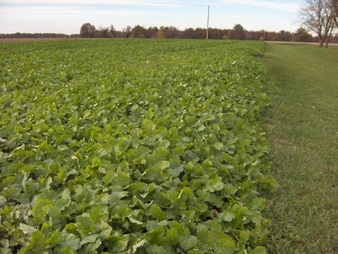
Turnips planted as cover crop on the Culler Farm sweet corn field.
The benefits to the landowner can include improved soil health, increased crop production, and reduction of the amount and cost of fertilizers and pesticides needed. For example, Gabe Brown, a North Dakota farmer and advocate for cover crops reports that he has been able to cut use of commercial fertilizer by more than 90 percent and the use of herbicides by more than 75 percent.
On April 3 of this year, I had the opportunity to tour the Chariton County SWCD Soil Health Demonstration Farm. The 85-acre demonstration farm is owned by Associated Electric Cooperative Inc. and is located near Keytesville. The soil health demonstration and research farm is operated by the Chariton County Soil and Water Conservation District and involves several partners, including local farmers, USDA Natural Resources Conservation Service, USDA Agricultural Research Service, Missouri Department of Conservation, Missouri Department of Natural Resources, Syngenta, Pioneer, Cover Crop Solutions, Green Cover Seed, AgriVision LLC, and Associated Electric Cooperative Inc. Dr. Ranjith Udawatta, research associate professor at the University of Missouri Columbia, is leading a research team to study the effects of cover crops on soil health, water quality and farm profit.
The first round of cover crops at the demonstration farm was planted last fall in a 65-acre field. The 65-acre field was divided into several different drainages using LIDAR technology, which is used to create topography maps. Nine different mixes of cover crops were planted last fall. The cover crop species, crop rotation (i.e. soybeans, wheat, corn) and tillage practice (all cover crop plots will be no-till) will be recorded each year for each plot. Water quality and flow of surface water will be measured for each drainage. Soil characteristics will also be measured for each plot. The farm also contains a control field on which no cover crops will be planted.
There is a 10-year lease agreement between Associated Electric Cooperative and the Chariton County Soil and Water Conservation District, which will provide a great opportunity to learn more about how to successfully implement cover crops in a Missouri row crop operation and the effects of this practice on water, soil and farm economics. If you are interested in learning more about cover crops, there are many resources available on the internet, such as Mr. Gabe Brown’s website at http://brownsranch.us/?id=1. >>OMW>>
Mary Culler
When my family immigrated to the United States from Germany in 1903, they lived somewhat nomadically for a few years. They first lived in Illinois where my great grandfather worked in coal mines then he traveled to Missouri where he became an entrepreneur in the grocery store business and ran a few small country stores in Owensville and Leslie, Mo. After a number of moves, the family eventually settled in the Missouri River town of Washington, where my mother was born and my parents have now retired.
This may be one of the reasons the Missouri River is one of my favorite rivers. Draining water from 10 states, with a watershed that is more than a half-million square miles in size, few other rivers in the United States can compare for their historical significance and role in navigation, water supply to communities, and importance to wildlife and fisheries. Perhaps this is why its management is often a difficult struggle between upstream and downstream interests and the stakeholders that depend on the various services provided by the river.
Last spring, I was excited to find out that Missouri River Relief www.riverrelief.org was hosting a cleanup in the Lower Grand River Watershed at Brunswick, where the Grand River meets the Missouri. Missouri River Relief is an organization that was formed in 2001, and since that time has organized more than 17,000 volunteers to conduct 104 cleanup events on the Missouri River. These cleanup events have resulted in more than 700 tons of trash being removed from the river and its surrounding banks. On May 19, 2012, community volunteers and state and federal fisheries agencies met at the Brunswick Access. There were 120 volunteers who participated and removed 4.2 tons of trash.
A volunteer crew unloads at the Brunswick Access after spending a few hours picking up trash on the Missouri River.
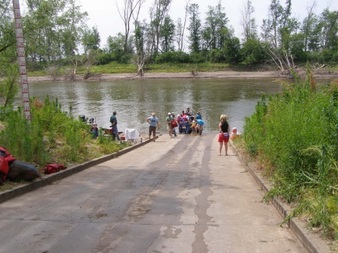
I teamed up with Stream Team biologist, Naomi Gebo. Together, along with a group of students from Brunswick High School, we climbed in one of the cleanup boats. Our boat was driven by Missouri River Relief staff safely upstream a few miles on the Missouri to a location that had been scouted and identified as having a high amount of trash present. Our team spent about 2 hours picking up trash along the banks and then returned to the Brunswick Access where we met the other teams that were returning from the cleanup. We then enjoyed a lunch of sandwiches, chips and cookies that were prepared by the local Girl Scout Troop 70835 and their mothers.
In total, 16.5 miles of river was cleaned for trash, including 3 miles on the Grand River and 13.5 miles of the Missouri. After the event, volunteers displayed their unique trash discoveries and awards were given for different categories, such as weirdest or most useful trash.
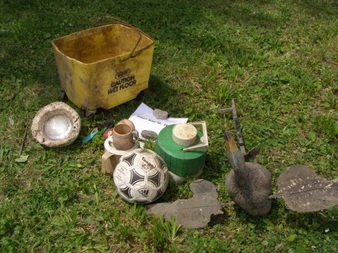
Volunteers displayed their unique items found during the trash cleanup.
Sponsors for this event included the Missouri Conservation Heritage Foundation, Missouri American Water, Missouri Department of Conservation, and Pat Jones. There were also many partners for this event, including MFA Agriservices - Brunswick River Terminal, Brunswick Bait & Tackle, the Brunswicker, Brunswick Redevelopment and Revitalization Committee, Brunswick High School, the city of Brunswick, Ted DeLozier, Joe Moser, Prenger Foods, Harmon’s Service, Girl Scout Troop 70835, and Missouri Stream Team.
Missouri River Relief has posted their 2013 cleanup schedule on their website at http://www.riverrelief.org/updates/entry/2013-schedule/. These events are a great opportunity to spend a day on the river, meet new people and help maintain the beauty of one of our nation’s largest rivers.

A number of sponsors and partners made the Brunswick cleanup a success.
If you live near a river or stream in the Lower Grand River watershed that you think could benefit from a trash cleanup, please let me know. I would like to work with local volunteers to help make the rivers and streams in your area a cleaner place to boat, fish and view wildlife. >>OMW>>
On March 21, 102 students and their teachers gathered at the First Baptist Church in Princeton for the Mercer County Water Festival. The water festival is a program that is hosted by MU-Extension. Partners for the event included the Missouri Department of Conservation, Mercer County Soil and Water Conservation District, and the Harrison County Soil and Water Conservation District.
Participating schools included Princeton, Spickard, Ridgeway and South Harrison. The majority of the students were in the 5th grade, but some of the schools also brought 4th graders.
Students rotated through nine different learning stations that were 20 minutes in length. The learning stations taught several subjects including soil erosion, the water cycle, food webs, topographic maps, point and nonpoint source pollution, birds and wetlands, soil formation, and microscope use. In order to evaluate the impact of the sessions on students’ learning, students took a pre-test prior to attending the event, and then took a post-test at the conclusion of the day. The learning sessions at the festival are designed to meet state standards and help prepare students for their school’s MAP testing.
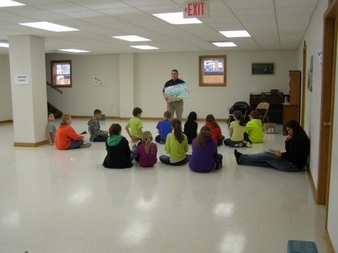
TJ Peacher from the Missouri Department of Conservation teaches students about the water cycle at the 2013 Mercer County Water Festival.
The Mercer County Water Festival has been held for several years. If you are a teacher or principal at a nearby school and are interested in attending the next Mercer County Water Festival, you may contact Shaun Murphy, MU-Extension, CPD/Regional Youth Specialist at murphyse@missouri.edu. >>OMW>>
The drought of 2012 was certainly one to remember, and drought conditions continue to persist in parts of the Midwest as we begin 2013. Since the majority of public water systems in the Lower Grand River Watershed receive drinking water from surface reservoirs (i.e. lakes), the water supply for many of our communities in the Lower Grand River Watershed depends heavily on the amount of precipitation received. With this in mind, I thought this newsletter would be a good opportunity to share a few water saving tips.
We have all probably heard that we can take shorter showers, turn off the water while brushing our teeth, install low flow toilets, or fix the leaking faucet or running toilet, but what are some of the lesser known ways to save? I recently visited a website at http://wateruseitwisely.com, where there are more than 100 tips for conserving water.
 |
|
These are my top 10 picks for new ways you may have not considered to help conserve water.
|
- Use the garbage disposal sparingly. Compost food waste instead.
- Collect water you use to wash fruit and vegetables, and use it to water plants.
- Don’t use running water to thaw food. Defrost food in the refrigerator.
- Insulate hot water pipes for more immediate hot water at the faucet. This will save both water and energy.
- Use a hose nozzle so that you can turn off a running hose.
- Wash your pets outside in an area that needs water.
- Check the root zone of your garden before watering. If the ground is moist two inches under the soil surface, there is still enough water in the ground.
- Aerate your lawn at least once a year so that water can reach the roots and not run off the ground’s surface.
- Consider reusing bath towels, to reduce loads of laundry.
- Direct rain gutters towards water loving plants or catch rain in a rain barrel. See instructions for making a rain barrel at http://watershedcommittee.org/ >>OMW>>
What do you do with leftover prescription drugs? Do you leave them in the bathroom cabinet? Do you flush them down the toilet or throw them in the trash? If you leave prescriptions in the bathroom cabinet for an extended period of time, there is a greater chance they could end up in the hands of someone who should not be taking the medication.These medications are a hazard to children, teenagers, and others if they accidentally or intentionally take the medication and overdose on them.
In addition to being a health hazard at your home, prescription drugs can negatively affect the environment. Prescription drugs that are flushed down the toilet are not completely removed by wastewater treatment systems. Medications that are flushed down the toilet can eventually reach downstream waters that may be used by other communities for drinking water. Pharmaceuticals in rivers and streams also have a negative impact on aquatic life. Several studies of riverine fish in the United States have shown that male fish are taking on female reproductive characteristics, which is believed to be caused by an increase of female hormones in rivers due to certain pharmaceuticals passing through wastewater treatment facilities.
Properly disposing of unused prescription drugs is not only important for downstream water quality and public health, it is also important for home safety. Do you have old prescriptions at home? The Drug Enforcement Agency is hosting the 5th National Pharmaceutical Take-Back event on Saturday April 27 from 10 a.m. to 2 p.m. Some of the drop-off locations near the Lower Grand River Watershed include:
- Mercer County Sheriff’s Office, Princeton.
- Putnam County Sheriff’s Office, Unionville.
- Keytesville Community Center, Keytesville.
- C&R Supermarket, Macon.
Just drop off your unused prescription drugs at any of these locations on Saturday April 27, from 10 a.m. to 2 p.m., and the medications will be disposed of responsibly. If you miss this event, the next national take-back day should occur in September 2013. >>OMW>>
Are you interested in providing input about the department’s watershed initiative? Do you have an idea for a water quality project in the watershed? Does your community or school need financial assistance for a project? Are you interested in water education? Do you want to form a Stream Team or join an existing Stream Team? Do you have ideas that could benefit the communities and resources of this watershed? Do you have questions about the watershed or about the Our Missouri Waters initiative? If you have any ideas, comments, questions or suggestions, please give me a call or send me an email. I can be reached at 660-385-8000 or at Mary.Culler@dnr.mo.gov. >>OMW>>
|